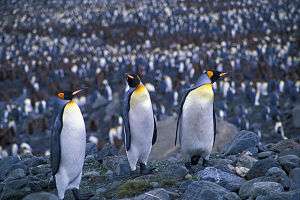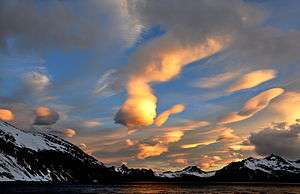South Georgia Island
South Georgia Island is a sub-Antarctic island administered by the United Kingdom as part of South Georgia and the South Sandwich Islands. It is located 1,390 km southeast of the Falkland Islands and 2,150 km from South America. It is the home of vast numbers of birds and marine life, but its remote location and lack of access makes it a rare destination for tourists.

Destinations
- Grytviken - The former whaling station.
- King Edward Point - The research station and post office.
Get in
There are no airstrips on the island, so aside from an occasional overflight from military aircraft, which do not land, the only access to the island is by boat. Most tourists arrive on icebreakers and other large vessels as a part of a trip to the Antarctic Peninsula, although a handful of smaller boats also brave the rough passage to the island. Whether on a small or large boat, even the crustiest old seaman should expect to become seasick during the crossing and should bring appropriate medications.
Companies that can help to arrange travel to the islands include:
- Bark Europa. A sailing ship (square-rigged) offering a 53-day trip to Antarctica, South Georgia, Tristan da Cunha and across to Cape Town South Africa and 22-day trips to Antarctica on a yearly basis.
- Cheeseman's Ecology Safaris. A small friendly company that leads two near-yearly expeditions: one to the Falklands, South Georgia and the Antarctic Peninsula and one to South Georgia and the Falklands. The South Georgia and Falklands trip spends about ten days on South Georgia, making it a great option for anyone wanting to maximize their time on this island.
- Quark Expeditions. Quark is a larger company known for travels to remote locations. They stop in South Georgia for 3-4 days as part of some of their Antarctic Peninsula trips.
- Golden Fleece Expeditions. Run by Jerome Poncet, a resident of the Falklands who has been visiting South Georgia longer than anyone else. His boat, the Golden Fleece, holds eight passengers, and must be chartered well in advance as Jerome is in high demand by National Geographic, the BBC, and various research groups.
- Expedition Sail. Run by Hamish Laird, the sailboat SEAL takes 4-6 passengers and is available for private expeditions, research, filming, and sometimes offers "by the bunk" trips for individuals to South Georgia.
- Geographic Expeditions . GeoEx offers a 23-day expedition that crosses South Georgia Island following the famed route of Ernest Shackleton. Trip is led by noted expedition leaders Dave Hahn and Peter Hillary.
- Haka Expeditions.Run by Expeditions Leaders Sebastian Arrebola and Christian Rotger. Haka Expeditions offers trips to South Georgia and Antarctica Peninsula,in addition they offer tailor made trips, corporate and incentive trips.
- National Geographic Expeditions. This cruise also includes a visit to Antarctica and the Falkland Islands. The site has all the information you'll need for the trip.
Get around

There are no roads on the island, so all travel is by boat or on foot. The island is mountainous and covered by massive glaciers, so travel by land requires appropriate gear and backcountry travel skills.
See
This island is a paradise for wildlife lovers, with literally millions and millions of animals going about their lives with little concern for the handful of humans that occasionally appear. The destinations below are listed geographically from northwest to southeast.
Willis Island
Located at the extreme northwest tip of the island, Willis Island is accessible only by a difficult and mildly dangerous landing onto a rocky cliff, followed by a steep ascent over rock and through tussocks. The island is home to massive numbers of black-browed, grey-headed and light-mantled sooty albatross, as well as macaroni penguins.
Bird Island
Bird Island is closed to all tourism and operates as a research area for the British Antarctic Survey. Birds on the island include wandering albatross, giant petrels, and numerous other species.
Elsehul
Elsehul is a small harbor which is nearly impossible to land in during December and January due to the vast numbers of grumpy fur seals that overrun the beaches. During other times of the year it is home to elephant seals, gentoo penguins, king penguins, sheathbills, and grey-headed albatross.
Right Whale Bay
Right Whale Bay lies on the northwestern portion of the island and is often a first stop for cruise ships. Elephant seals and a small colony of king penguins monopolize the area from September through November, after which thousands of fur seals take over the beach through February.
Salisbury Plain
|
Introduced Species Reindeer were introduced to South Georgia by Norwegian whalers, and the animals established several herds throughout the island. As an introduced species they stressed the environment, browsing and trampling local vegetation and occasionally disrupting nesting birds, including penguins. Arguments were made that the reindeer should be eradicated to help restore the island to a more pristine condition, but opponents argued against a wholesale slaughter and pointed out that the species provided an interesting scientific test group since the animals had to completely invert their natural breeding cycle to accommodate the reversed seasons of the southern hemisphere. After many years of deliberation, the island's management plan was updated to include extermination of the reindeer in order to protect the native wildlife and vegetation, and more than 5,000 reindeer were killed between 2013 and 2014. Similarly, rats arrived with the whalers and proceeded to decimate the island's nesting bird population. In 2015, a multiyear program aimed at eradicating rats from the island completed. The effort is the largest rat eradication in history, covering an area seven times larger than the previous record holder, Campbell Island in New Zealand. Nesting South Georgia pipits have already been found in areas that were previously abandoned, South Georgia pintail numbers appear to be climbing, and the hope is that with the rats gone over one hundred million seabirds will reclaim their ancestral home. |
Another enormous king penguin rookery, Salisbury Plain is also home to vast numbers of penguins and seals.
Albatross Island
Albatross Island is home to limited numbers of wandering albatross, which is among the largest and most threatened birds in the world. As of 2005 the island has been closed to tourists.
Prion Island
Prion Island is another home to the wandering albatross. Half of the island remains open to tourism, although several restrictions have been put in place to protect the birds. A boardwalk is being built on the island to make access easier and also to protect the fragile vegetation on the island.
Grytviken
A former whaling station, Grytviken is now the centre of what limited government exists on the island. Most ships are met by a government representative who explains any rules and collects a per-passenger fee. There is a museum that explains island history, and the British Antarctic Survey maintains across from the station at King Edward Point. Grytviken is also the burial place of Ernest Shackleton, the famous Antarctic explorer.
St. Andrew's Bay
Some people believe that St. Andrew's Bay holds more density of wildlife than any other place on earth, and a first view of the massive king penguin colony and seal rookery makes this claim hard to doubt. St. Andrew's Bay is a sight that causes disbelief with hundreds of thousands of king penguins filling every available inch of space, and thousands of elephant seals and fur seals occupying the sands along the water. The sights, sounds, and smells of this bay will not soon be forgotten.
Cooper Bay
Visitors to Cooper Bay arrive to see one of the islands most accessible macaroni penguin colonies.
Drygalski Fjord
Drygalski is a steep-walled fjord that surprisingly contains a small rookery of Weddell seals, animals normally only found in Antarctica. Numerous glaciers and spectacular scenery make this a common destination for island visitors.
Do
- Photography
- Skiing
- Hiking
- Sailing
- Research
- Penguin Spotting
Eat
Unless permitted as an expedition, no food is allowed to be taken ashore due to strict biosecurity protocols. Fishing and hunting on the island are prohibited.
Sleep
Any overnight stay on the island requires a permit costing £1,000, so nearly all visitors to the island sleep on their boat.
Connect
Mail can be sent from Grytviken, and is picked up approximately every two weeks. The only other means of communicating with the outside world is via satellite phone, which most boats make available for between $2 and $5 per minute. There is no publicly available internet access.